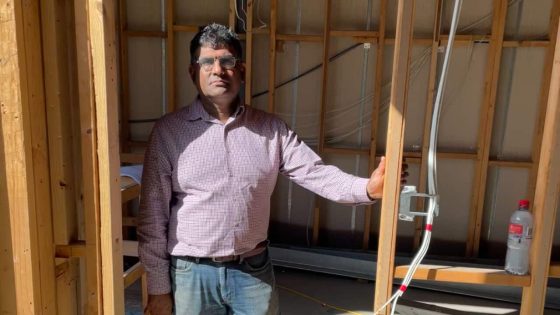Watch Insight’s episode Buildings Blocked — defected properties, business owners drowning in debt and a dire mental health toll, what can be done to rebuild a broken building industry? — on Tuesday 8:30pm on SBS or on .
When Sid Prakash decided to build a family home in 2018, he did not expect that six years on, it would still be incomplete.
Like many Australians, Sid dreamed of a place to call his own.
But what started off as a positive experience turned sour as the months passed.
“It was a dream that’s kind of subsequently turned into a nightmare,” Sid told Insight.
Eighteen months after Sid signed the contract to build with Pinnacle Builders, the company folded in 2020 and left the Melbourne family an unfinished build with several defects.
For the family of four, the delayed build has meant they’ve had to live with Sid’s parents for the past six years.
“I can’t even think to imagine what would have occurred if this wasn’t an option,” he added.
Data from the Australian Securities and Investments Commission (ASIC) shows almost 3,000 building and construction companies (or eight per day) went under over the past financial year — that’s more businesses collapsing than in any other industry in the country.
As record numbers of builders collapse, experts say there’s not enough protection for home builders and buyers caught up in the fallout.
Lack of protection makes consumers vulnerable
Bradley Hastings researches company collapses in the construction and building industry.
As a research associate for the University of New South Wales’ Business Insights Institute, he found the lack of protective mechanisms for consumers are made more apparent during a time where confidence is needed in the industry.
“If I compare house deposits to other large investments that Australians might make in their lifetime, like superannuation, or even bank savings, there are protection mechanisms for those types of investments,” Hastings said.
“In the residential construction industry, those regulations, those checks and balances don’t exist.”
Hastings says the money someone pays to their builder doesn’t have to be used for that home builder’s project but can be used freely for anything they’d like.
“So, I might pay a deposit for a home builder, and they can spend that however they like. They can buy a new Toyota Hilux, or go on a holiday to Thailand,” he said.
“There’s currently no regulation, which says that money needs to be ring-fenced, and put in an account to be spent on the project by with which I’m investing in.”
Out of pocket over $800,000
When a building or construction company goes under, consumers aren’t the only ones to feel the domino effect of a strained sector.
In March of 2024, Rork Projects, which did building fit-outs and refurbishments for major Australian clients — many of which were government, collapsed, owing more than $25 million to creditors.
The company went into voluntary administration. citing a “tsunami of impossible economic conditions”.
It had 63 active projects underway in several states.
When Rork Projects collapsed, subcontractor Chris Nowaczyk was at the pub having a beer after a week of running his joinery fit-out business in Canberra.
He got a call that would upend his entire life — Rork had gone into administration and he would be out of pocket upwards of $800,000.
“I was borrowing money from my mates just to pay my staff members,” Nowaczyk told Insight.
Amie and Anthony Lloyd, who own a small carpentry business in Canberra, were also hit hard by Rork’s collapse — though it wasn’t the first insolvency they’d been caught up in.
“We’ve been caught up by three: Project Coordination, Rork Projects, and National Projects and Maintenance,” Anthony told Insight.
Collectively, the collapses have put them out of pocket almost half a million dollars.
When a builder goes under, subcontractors debts don’t disappear. They still have to pay their own overheads, such as suppliers, employees and taxes.
Amie believes many construction companies “rack up millions of dollars of debt, and they just walk away”.
“It’s just another kick in the guts,” Amie said.
Professor Jason Harris says there’s a lack of regulation because it means it would halt housing target progress. Source: Supplied
The watchdog that nobody fears
Professor Jason Harris, a professor of corporate law at the University of Sydney says that the issue of insolvent trading in the building and construction sector is rife and it is not being properly policed by ASIC, the federal government’s corporate watchdog.
“ASIC only looks at less than 1 per cent of the files that liquidators send to it, which are saying we have evidence of insolvent trading liability,” Harris told Insight.
“It just doesn’t have the resources, doesn’t have the manpower or the money to actually deal with this problem — because it’s a problem on a massive scale.
“It’s the watchdog that nobody fears because it’s not bringing enough of these cases.”
While many of these companies walk away and subcontractors absorb their debt, many re-emerge as the director of a new company and continue to trade.
“Unless we can prove that those directors have broken the law, and then ASIC bans them or the court disqualifies them, then they’re free to start up as many businesses as they like.”
“The bad guys know that they’re highly unlikely to get caught, which is why they keep doing it.”
“People have turned this into a business model.”
SBS Insight contacted ASIC but it declined to comment.
Why the government is okay with things as they are
The issue of subcontractors being out of pocket when a builder goes under is not a new one.
In 2012, Bruce Collins headed up a report for the NSW government which made 44 recommendations to address the issue of subcontractors being left out of pocket.
In 2015 the issue was similarly explored in a Senate Economics References Committee report.
Despite this, they regularly remain left in financial limbo when a company goes insolvent.
Harris says governments are comfortable not addressing the situation, as effective regulation would slow building and construction speeds and make it more expensive.
“I think that’s the trade-off that we’re making as a society. That we’re saying we want more homes, we want them faster, we want them cheaper. But that comes at a cost.”
Sid says he would never choose to build his own home if he had his time again.
“Anybody who wants to build a home at the moment, they’re really up for a lot of pain,” he said.
“Consumer protection is lacking, it’s a difficult situation out there.”
Sid’s family do not know when their home build will be finished.
And for more stories head to , hosted by Kumi Taguchi. From sex and relationships to health, wealth, and grief Insightful offers deeper dives into the lives and first-person stories of former guests from the acclaimed TV show, Insight.
Follow Insightful on the , , , or wherever you get your podcasts.
Source Agencies



